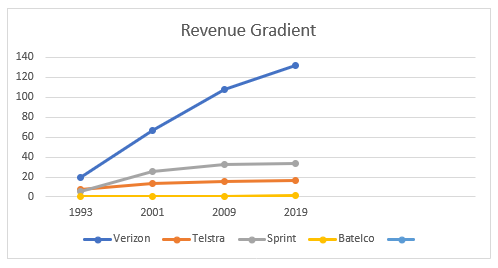A rewind of the evolution from 1G to 5G
From 1G to 5G
The journey from 1G to 5G seems to recent and time has really flown. By means of the below blog, I have attempted to provide a quick summary of the journey and how we fared.
Towards the end, you can also see the revenue impact on a select few Telcos handpicked from across the globe with the evolution of each Generation of Telecom.
1G Era 1987-1991
“It was PHENOMENAL but was not enough.”
What Happened Here?
- Engineer Neil Papworth sent the first SMS on December 3rd, 1992, when he wrote “merry Christmas” on a computer and sent it to the cell phone of Vodafone director Richard Jarvis
- Inception of AMPS (Advanced Mobile Phone System) technology from the pre-existing IMPS (Improved Mobile Telephone System) for voice transmission.
- Connectivity established seamless mobile connectivity introducing mobile voice services.
- 1G Introduced Analog voice.
What went wrong?
- Poor voice quality
- Poor battery life
- Large phone size
- No security
- Limited capacity
- Poor reliability
The Revenue Impact:
Since the call rates were too high & the users too less, this was only the beginning of the Telecom revolution and at this point, service providers were focused on technological strides as success stories over revenue generation or acquiring subscriber base. This was essential for the operators as it defined their level of readiness to capture the market faster and better in the coming days.
2G Era 1991-2001:
“A revolutionary milestone in telecommunication sector”
What Happened here:
- 2G: First Wireless digital transmission came with 2G in 1991.
- GSM – Global Systems for Mobile Communication enabled Data transfer on top of voice at a speed of 30-35 kbps (A joke in modern telecommunication terms).
- 2G was developed, primarily, to transfer voice, fax, MMS and SMS services.
- By use of digital voice compression, the TDMA (Time Division Multiple Access) standards supported three times as many voice channels in the same bandwidth as the old analog systems.
- The ‘E’ & ‘G’ Symbols on the mobile network were seen first during the 2G era.
- Data was responsible for constant spike in revenues in telecom operators in addition to the voice revenues. 40% of the revenues were collected for Data.
- 2.5G saw the introduction of GPRS as enhanced Data services. GPRS can be viewed as a boosted data service for GSM users, but using packet switching and multiplexing techniques. The maximum transfer speed that can be reached via GPRS is approximately 170 Kbps.
- 2.75G saw the entry of EDGE (Enhanced Data rates for GSM Evolution) technology.
- Data transmission rate saw 4X increase from 170kbps to 500kbps (practical application). In theory it was said to be 1mbps.
- EDGE transferred data in fewer seconds if we compare it with GPRS Technology. For example, a typical text file of 40KB was transferred in only 2 seconds as compared to the transfer from GPRS technology, which was 6 seconds.
What went wrong?
- Required strong digital signals to help mobile phones work. If there was no network coverage, digital signals weakened.
- Systems were unable to handle complex data like videos.
- As the generation moved towards 3G, the user requirement was too complex for 2G to satisfy.
The Revenue Impact:
While the biggest highlight of the era may have been the introduction of data transfer capabilities on a mobile device, the maximum revenue impact seems to be created by SMS services. Telecom operators across the globe saw multi-fold increase in their revenue in this period, with some operators reporting 5X growth.
3G Era 2001-2009
“Showed us the unending potential of Data yet did not fulfil its own potential”
What Happened Here?
- 3G network was introduced in 1998, we saw its establishment in the early 2000s.
- The max speed of 3G was estimated to be around 2 Mbps for stationary devices and 384 Kbps in mobile phones. The theoretical max speed was 21.6 Mbps.
- It was based on CDMA2000 (Code Division Multiple Access) & EDGE technologies. (EDGE was superior enough to support 3G on its own).
- 3G introduced media streaming.
- Data in 3G was broken down into small pieces or packets and then sent to the destination, unlike 2G which used circuit switching.
- This was revolutionary as users paid only for the data they spent rather than the time spent online.
- “Data is money” probably started its inception in the mid-2000s as there was a surge in data utilization by consumers.
- Multimedia, navigation, mobile apps, browsers, conference calls, mobile TV all saw their inception in the early 3G era.
- 5G was conceptualized and released with HSPA (High Speed Packet Access) marking the iconic ‘H’ symbol on the mobile network.
- It was all about data in the 3.5G. Data transmission rates went up to 14mbps
- Saw the release of HSPA+ or as we know it ‘H+’ symbol on the network.
- Data speeds went up even further with max speed of 42mbps
- Although 3G did not see operators exponentially increase revenue as the 2G era, tier 1 operators saw significant growth as Data consumption increased.
What Went Wrong?
- Messy Architecture
- Demanded 3G compatible handsets
- Cost of upgrading to 3G device was too high
- Power consumption was high
The Revenue Impact:
During the mid-2000s towards the dawn of 4G, operators focused on increasing their subscriber base. From 2002 to 2009, they saw an increase of ~4.1Bn. But since data dominated over calls, the spike in revenue was not satisfactory. This period turned out to be a huge revenue booster for device manufacturers as the need to have a 3G compatible device/handset became a necessity as it enabled the transformation of phones into smart phones.
4G Era 2010-2019:
“4G introduced us to a faster world with a greater Data capacity”
What Happened Here?
- 4G saw an overlap of itself with the 3G as in 2008, 4G technology started to roll out but had issues to commercially announce the then communication system as 4G due to minimum standard requirements which were not fulfilled.
- The speed of 3G quickly became insufficient as technology & smartphones evolved resulting in heavier files and bulkier data flows.
- It provided a quality that enriched user experience with advancedgaming services, HD mobile TV, Video Conferencing, 3D TV, IP telephony and other services that demand higher speeds.
- With the implementation of 4G, some 3G features are removed, such as the radio spectrum technology.
- A term MAGIC is used to explain the 4G technology.
- M – Mobile multimedia
- A – Anytime Anywhere.
- G – Global mobility support
- I – Integrated wireless solution
- C – Customized Personal Service
- 4G LTE (Long Term Evolution) was a complete redesign and simplification of 3G network architecture, resulting in a significant reduction in transfer latency and thus, increasing efficiency and speeds on the network.
- Users encountered a problem in accessing data while on a voice call with the 4G LTE, hence the inception of 4G VoLTE which simply meant voice over LTE enabling users to access 4G data and still be able to make calls.
- 4G carries 3X the data 3G UMTS (Universal Mobile Telecommunications System) carried and 6X the data 2G GSM network carried.
- 4G bandwidth is 200 Mbps, which meant that one could download a full-length movie in under 10 minutes!
What Went Wrong?
- 4G LTE network needs complex hardware
- 4G technology use many antennae & transmitters resulting in poor battery life.
- In areas without 4G coverage, consumers downgraded to 3G while still paying the cost of 4G.
- Higher Data consumption
The Revenue Impact:
In 2018, almost 300 million people connected to mobile internet for the first time, bringing the total connected population to more than 3.5 billion people globally. Revenues did not see a drastic increase for the operators especially in the tier 2 & 3 segments, as consumers demanded better connectivity, greater capacity & lower latency. This could only be afforded by the tier 1 operators, who could simply afford splurging on improving their network.
5G Era 2019 and beyond:
“5G is more than a generation, it is a promise to wonderland”
- 5G looks at us with a new experience in faster data rates, higher connection density, much lower latency, among other improvements.
- 5G is not an upgrade to 4G, but is in a league of its own, because it provides us the ability to connect thousands of devices at once giving the user the true sense of ‘real-time’ experience.
- This means the computing & processing can move to cloud and resulting in smaller IoT devices, reducing the cost of manufacturing & maintenance by optimizing network for the telecom operator.
- IoT will mean a lot different with the growth of 5G, as self-driving cars may yet become a reality even in India.
- Since increasing subscriber base in tier 1 cities is no longer an enticing prospect for Telcos, they will look at generating new streams of revenue with the maturity of MU-MIMO and achieving data speeds of up to 35Gbps.
- 5Gtechnology may use a variety of spectrum bands, including millimetre wave (mmWave) radio spectrum, which can carry very large amounts of data a short distance.
- 5G mobile technology can usher in new immersive experiences such as VR and AR with faster, more uniform data rates, lower latency, and lower cost-per-bit.
- 5Gcan enable new services that can transform industries with ultra-reliable, available, low-latency links like remote control of critical infrastructure, vehicles, and medical procedures.
- Here are some revolutionary use cases 5G will bring in:
- Fuelling precision agriculture — even the cotton found in a simple dress uses 5G.
- Enabling reliable wireless IoT connectivity at transport hubs
- Essential to the future autonomous vehicles with V2X & smart logistics within our grasp.
- For closer collaborations at the workplace using real time insights & XRs.
- Bringing immersive, virtual customized shopping experiences anywhere to the consumer.
- Driving the next industrial revolution with flexible manufacturing with XR guided execution, smart surveillance, real time supply chain visibility using blockchain & predictive maintenance.
- With real-time asset tracking and efficient delivery using drones.
The Revenue Impact:
As per Qualcomm, 5G will extend its arms out into the enterprise and will see a massive growth. 5G is driving global growth.
- $13.2 Trillion dollars of global economic output
- 22.3 Million new jobs create
- $2.1 Trillion dollars in GDP growth
Penetration into OEMs, operators, content creators, app developers, and consumers) could alone support up to 22.3 million jobs, or more than one job for every person in Beijing, China.
Here is a revenue gradient chart for Tier 1, Tier 2 & Tier 3 operators for comparison.
References:
https://www.statista.com/statistics/226065/global-mobile-subscriber-forecast/
https://www.sciencedirect.com/topics/engineering/advanced-mobile-phone-system
https://mse238blog.stanford.edu/2017/07/ssound/1g-2g-5g-the-evolution-of-the-gs/
https://www.gsma.com/aboutus/history
https://www.itu.int/en/ITU-D/Documents/WTDC_1994_FINAL_REPORT.PDF
https://www.itu.int/ITU-D/ict/publications/wtdr_99/material/wtdr99s.pdf
https://www.itu.int/dms_pub/itu-d/opb/ind/D-IND-WTDR-2006-SUM-PDF-E.pdf
https://www.qualcomm.com/invention/5g/economy
https://www.qualcomm.com/invention/5g/what-is-5g
https://www.igi-global.com/chapter/evolution-technologies-standards-deployment-networks/17444
http://protei.me/blog/telecom-news/the-mobile-wireless-communication-technology-journey/
Official Annual Revenue Reports:
Verizon: 1993-2019
Telstra: 1993-2019
Sprint: 1993-2019
Batelco: 1993-2019
Tigo: 1993-2019






